Christopher Parkinson, researcher for the CVMA, project introduces us to project and some of the important resources held at the Essex Record Office.
Essex is fortunate that during the 17th and 18th centuries two antiquaries wrote manuscripts which, amongst other things, described any heraldry then present in parish churches. Richard Symonds (1617-1660), an English Royalist, produced three volumes of genealogical collections which included descriptions of heraldry in different mediums to be seen in some Essex churches. While these three volumes are now with the Royal College of Arms in London, volumes 1 (covering the Hundreds of Witham, Thurstable, Winstree, Lexden and Tendring) and volume 2 (covering the Hundreds of Clavering, Uttlesford, Freshwell, Dunmow and Hinckford) are available on microfilm at the Essex Records Office (T/B 73). William Holman (1669-1730) was a congregational minister at Stepney, Middlesex before being transferred to Halstead. He visited every town and village in Essex in order to compile a history of Essex. His manuscript is now held by the Essex Records Office in just over 500 parts (T/P 195/-/-).

My particular interest in these documents is for research in stained glass heraldry that is now lost from the county. This will be included in an appendix for a forthcoming Catalogue of the Medieval Stained Glass of Essex to be published for the Corpus Vitrearum Medii Aevi, CVMA. Although the term Medii Aevi implies the ‘middle ages’, my co-author Dr Penny Hebgin-Barnes and myself will include glass up to 1800 in the catalogue within the old (pre-Greater London) county boundary. Surviving medieval including heraldic stained glass can bee seen on the CVMA website in the picture archive section;
http://www.cvma.ac.uk/jsp/locationIndex.do?countyCode=EX,
click on the dedication of the church and the stained glass from all periods will be displayed. While there are about 162 pre-1800 stained glass shields of arms currently surviving within the county, the Symonds and Holman manuscripts show that there was a substantially larger number of such shields in churches and secular buildings during the first half of the 18th century. Obviously their loss cannot be due to the actions of iconoclasts, but presumably caused by general decay and later ‘restorations’ where such damaged glass was removed.




